For many dog lovers, the joy of pet ownership comes with a significant caveat: allergies. While no dog is entirely “hypoallergenic” or truly non-shedding, many breeds are celebrated for producing fewer allergens and shedding minimally, making them a fantastic choice for individuals with sensitivities. Among these, medium-sized dogs offer a perfect balance – they are substantial enough for active lifestyles and companionship, yet often more manageable in space than their larger counterparts. If you’re looking for a loyal companion that fits comfortably into your home without leaving a trail of fur, exploring medium dog breeds that don’t shed much is an excellent starting point. This guide delves into some of the best options, offering insights into their unique characteristics and care requirements. For more options on low-shedding companions, you might also consider these good house dogs that don’t shed.
Understanding “Low-Shedding” Versus “Hypoallergenic”
It’s important to clarify the terms often used when discussing dogs for allergy sufferers. The term “hypoallergenic” is commonly used but can be misleading. All dogs produce allergens, primarily found in their dander (flakes of dead skin), saliva, and urine. What makes certain breeds more suitable for people with allergies is their coat type, which typically sheds very little. Less shedding means fewer allergen-laden hairs are released into the environment, thereby reducing the potential for allergic reactions.
These low-shedding breeds often have hair that grows continuously, similar to human hair, rather than fur that cycles through periods of heavy shedding. This continuous growth necessitates regular grooming and trimming to prevent matting and keep their coats healthy. While these dogs significantly reduce the amount of dander and hair in your home, they are not 100% allergen-free. Individuals with severe allergies should always spend time with a specific breed before bringing one home to ensure compatibility.
Top Medium Dog Breeds for Minimal Shedding
Medium-sized dogs offer the best of both worlds: they’re not too small to be fragile, nor too large to overwhelm smaller living spaces. Here are some of the most beloved medium dog breeds that don’t shed much, known for their charming personalities and low-maintenance coats when it comes to shedding.
Standard Schnauzer
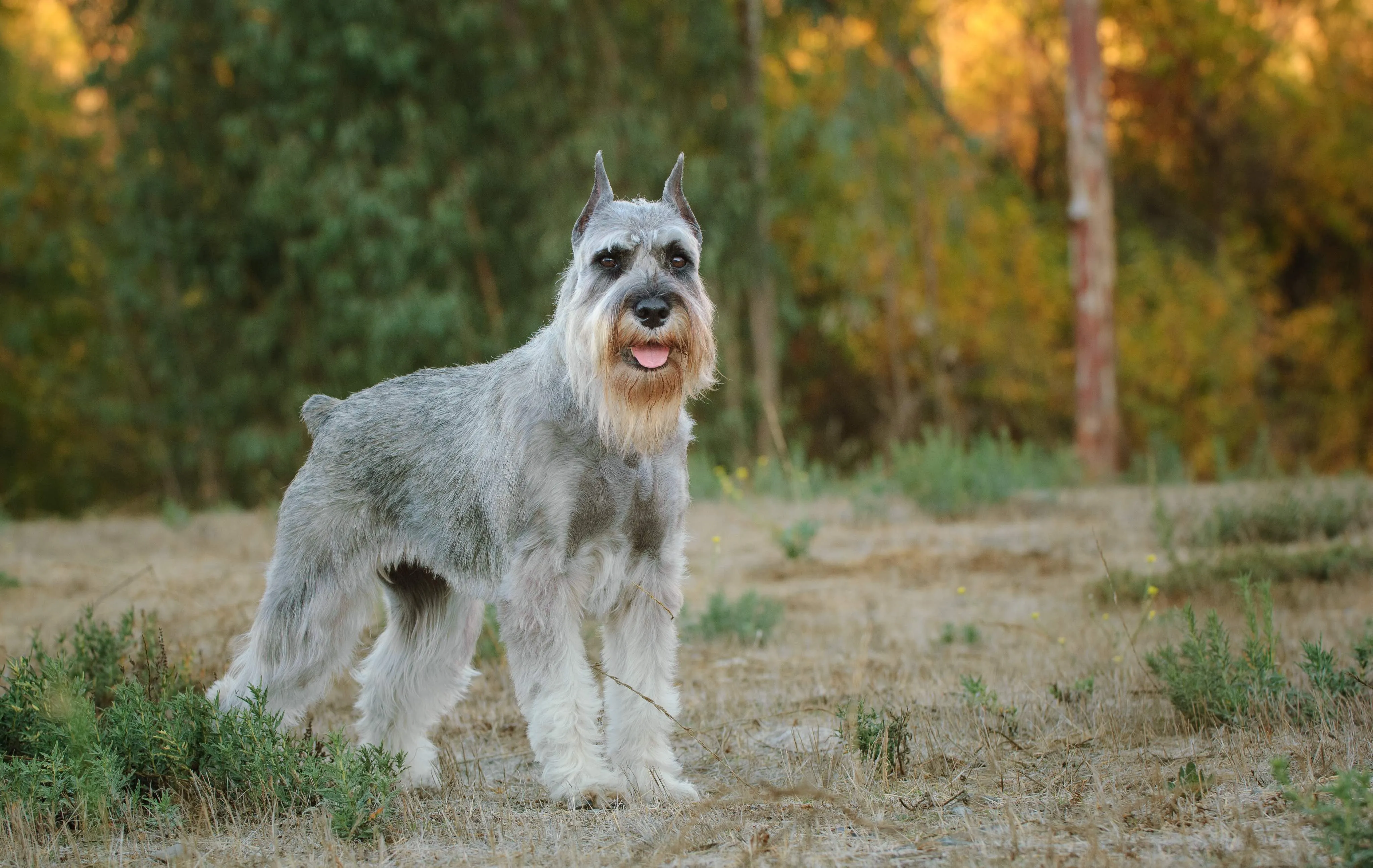 Salt and pepper Standard Schnauzer standing in a field
Salt and pepper Standard Schnauzer standing in a field
The Standard Schnauzer is a robust, intelligent, and spirited medium-sized dog, typically weighing between 30 and 45 pounds. These dogs are known for their distinctive “mustache” and eyebrows, and a wiry, dense coat that sheds minimally. Originally bred as farm dogs in Germany, they are protective, loyal, and highly trainable, making them excellent family companions. Their intelligence means they thrive with consistent training and mental stimulation, easily mastering commands and enjoying various dog sports.
While they don’t shed much, their wiry coat does require regular grooming to maintain its characteristic appearance and prevent matting. This typically involves weekly brushing and professional hand-stripping or clipping every few months. Standard Schnauzers are energetic and require at least an hour of vigorous exercise daily, such as long walks, playing fetch, or engaging in puzzle toys, to keep them happy and well-behaved. Their watchful nature also makes them excellent guard dogs, always alert to their surroundings.
Portuguese Water Dog
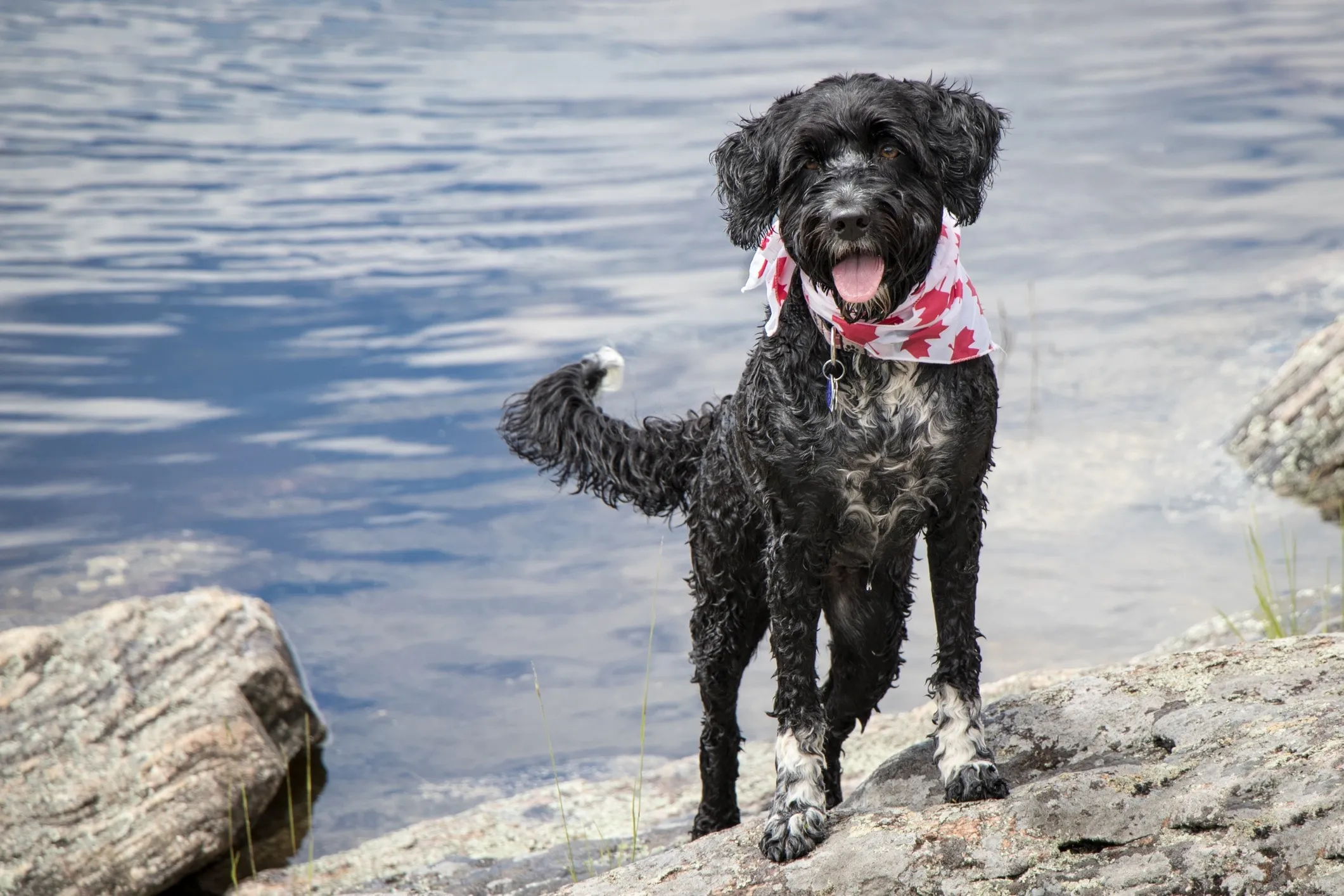 Black and white Portuguese Water Dog wearing a red maple leaf bandana in front of water
Black and white Portuguese Water Dog wearing a red maple leaf bandana in front of water
The Portuguese Water Dog is a highly energetic and intelligent medium-sized breed, with males typically weighing 42-60 pounds and females 35-50 pounds. True to their name, these dogs were historically bred to assist fishermen by herding fish into nets, retrieving lost tackle, and acting as couriers between boats and shore. Their most notable feature, besides their impressive intelligence, is their thick, curly coat, which is virtually non-shedding and waterproof. This coat comes in two types: wavy or curly, and requires regular grooming to prevent matting, including daily brushing and professional clipping every 6-8 weeks.
Portuguese Water Dogs are known for their friendly and affectionate temperament, making them wonderful family pets. They are highly trainable and eager to please, thriving on mental and physical challenges. Given their heritage, they absolutely adore water and excel at activities like swimming, dock diving, and retrieving. Regular, vigorous exercise is crucial for this breed to prevent boredom and destructive behaviors. Daily walks, runs, and plenty of playtime, especially involving water, will keep a Portuguese Water Dog happy and healthy.
Labradoodle
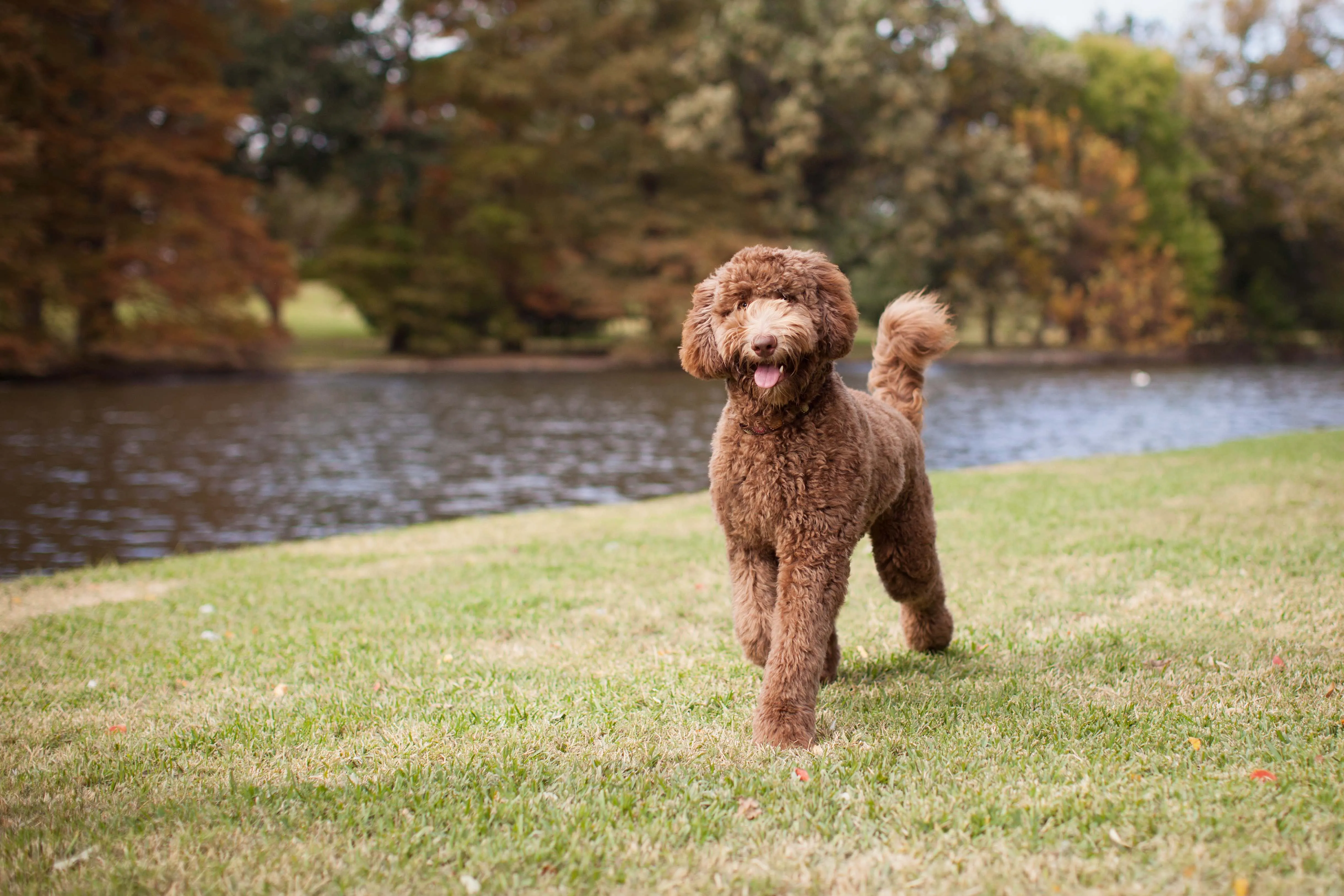 Brown standard Labradoodle walking in a park
Brown standard Labradoodle walking in a park
The Labradoodle is a popular crossbreed, typically resulting from a Labrador Retriever and a Poodle. While sizes can vary, many standard Labradoodles fall into the medium to large category, with weights often ranging from 50 to 65 pounds. They were originally bred in Australia as hypoallergenic guide dogs, combining the gentle nature of the Labrador with the low-shedding coat and intelligence of the Poodle. Their coats can be wavy, curly, or fleece-like, all of which tend to shed minimally.
Labradoodles are renowned for their intelligent, friendly, and outgoing personalities, making them excellent family pets. They are highly trainable and gentle, especially when properly socialized from a young age and given adequate exercise. This breed thrives on companionship and activity, requiring daily walks, playtime, and mental stimulation to keep them content. Regular grooming, including brushing several times a week and professional clipping every few months, is essential to keep their coats free of mats and looking their best.
Goldendoodle
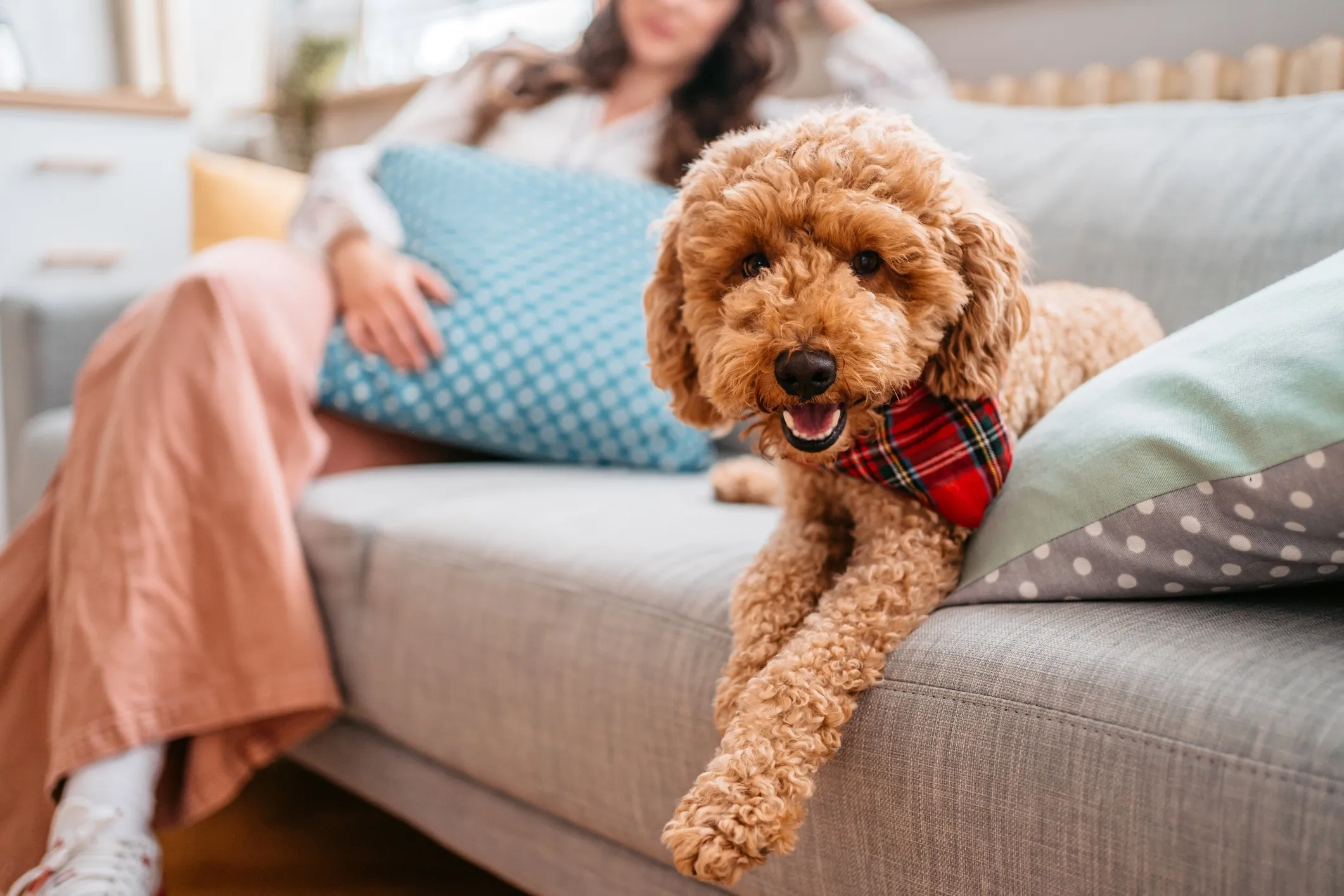 Goldendoodle lying on a couch with a person sitting in the background
Goldendoodle lying on a couch with a person sitting in the background
Similar to the Labradoodle, the Goldendoodle is another beloved “doodle” breed, a cross between a Golden Retriever and a Poodle. Depending on the size of the Poodle parent, Goldendoodles can range from miniature to standard, with many falling into the medium category, weighing between 45 and 75 pounds. They inherit the friendly disposition of the Golden Retriever and the low-shedding, intelligent traits of the Poodle, making them exceptional companions. Their coats come in various textures (wavy, curly, straight) and colors, with the wavy or curly types shedding the least.
Goldendoodles are known for their affectionate, patient, and highly intelligent nature. They are eager to please and easily trained, making them suitable for first-time dog owners and families with children. This active breed requires a good amount of daily exercise and mental engagement to prevent boredom. Their non-shedding coats demand regular grooming, including frequent brushing with a slicker brush to prevent matting and professional grooming appointments every 6-8 weeks.
Lagotto Romagnolo
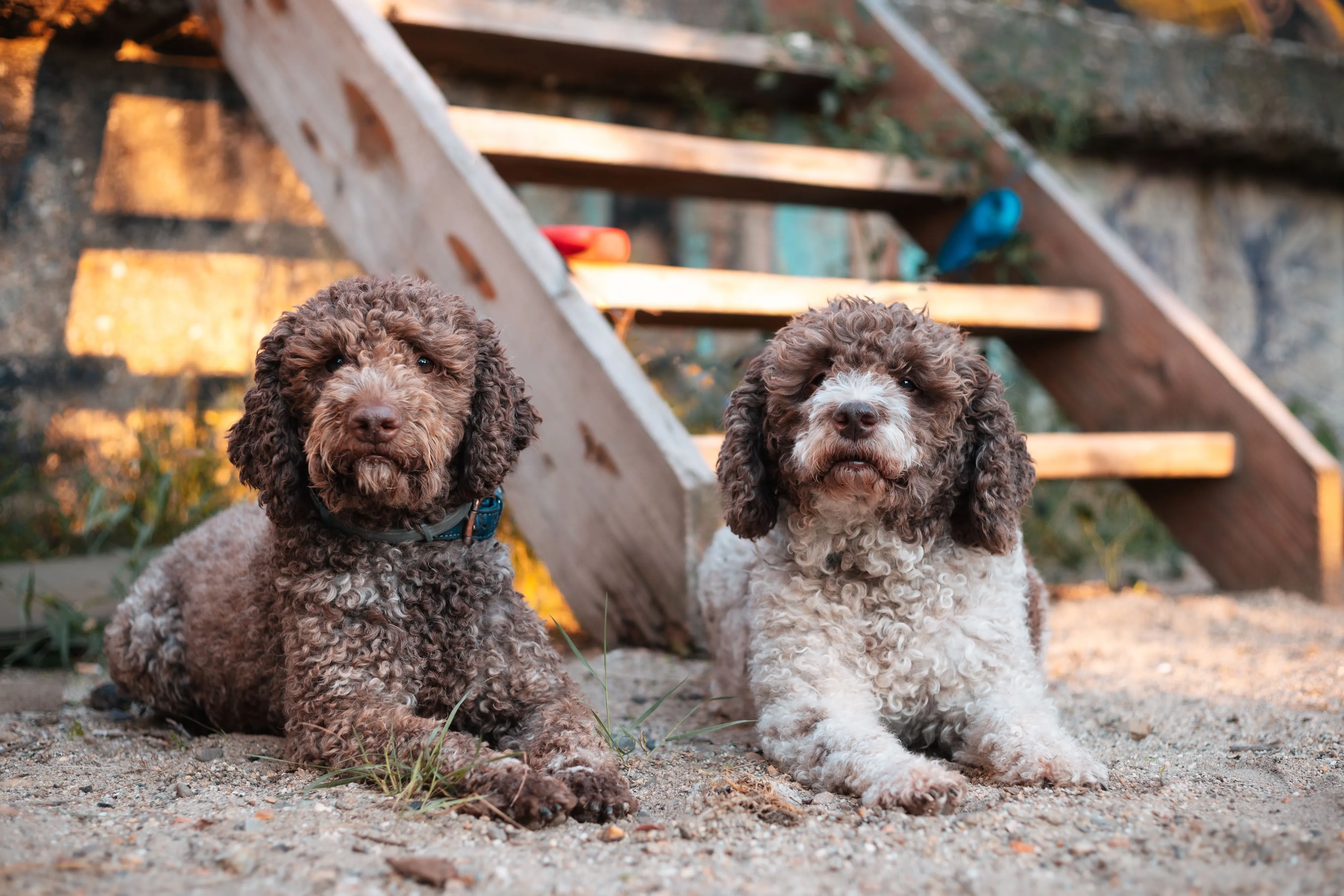 Two Lagotto Romagnolo dogs lying in dirt staring at the camera
Two Lagotto Romagnolo dogs lying in dirt staring at the camera
The Lagotto Romagnolo is an ancient Italian breed, originally bred as water retrievers and now renowned for their truffle-hunting abilities. This charming medium-sized dog typically weighs between 24-35 pounds and stands 16-19 inches tall. They possess a distinctive woolly, curly coat that is dense and waterproof, designed to protect them from cold waters. This unique coat sheds very little, making them an excellent choice for allergy sufferers, but it requires regular maintenance to prevent felting and matting. Daily brushing and clipping every few months are essential to keep their coat in good condition.
Lagotti Romagnoli are intelligent, eager to please, and generally good with children and other pets, making them wonderful family dogs. They have a lively and affectionate temperament. As working dogs, they have abundant energy and require significant physical and mental stimulation. Activities such as long walks, fetching, swimming, and puzzle toys are crucial to keep them engaged and prevent boredom. Their keen sense of smell also makes them excel in scent work and obedience training.
Irish Water Spaniel
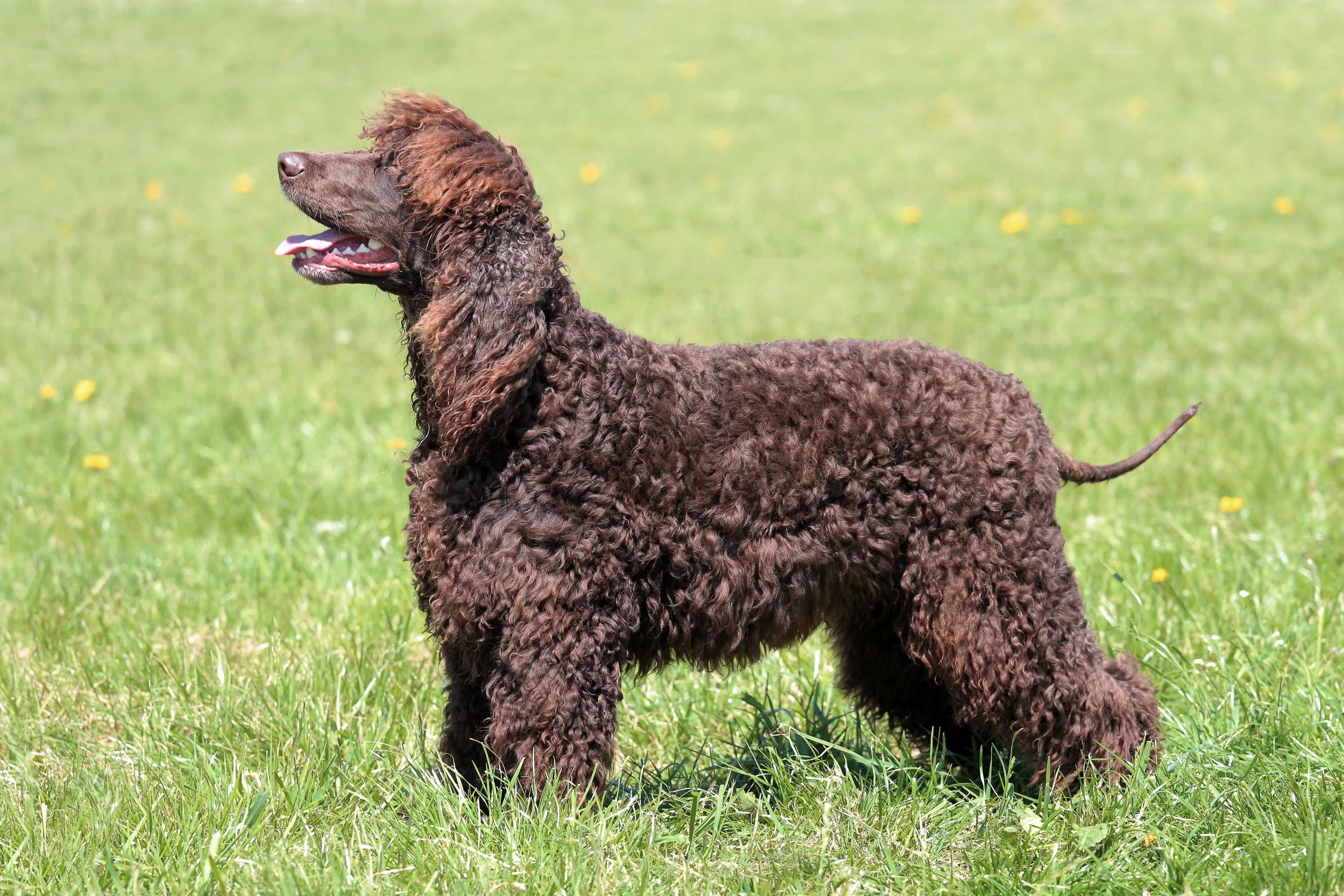 Brown Irish Water Spaniel profile
Brown Irish Water Spaniel profile
The Irish Water Spaniel is a distinctive and impressive medium-to-large breed, typically weighing 45-68 pounds. Known for their unique “rat tail” and a topknot of long, loose curls, they possess a dense, curly, waterproof coat that is always liver (dark brown) in color. This coat sheds minimally, making them a suitable option for those seeking a low-shedding dog, but it requires diligent grooming to prevent matting. Weekly brushing and professional trimming are necessary to keep their coat healthy and manageable.
Irish Water Spaniels are friendly, intelligent, and highly trainable, often displaying a clownish personality that endears them to their families. They are active dogs with high energy levels, originally bred for retrieving game from water. Consequently, they require substantial daily exercise, including long walks, runs, and especially swimming, to keep them physically and mentally stimulated. Without enough activity, they can become restless. Their loyal and affectionate nature makes them excellent companions for active families.
Aussiedoodle
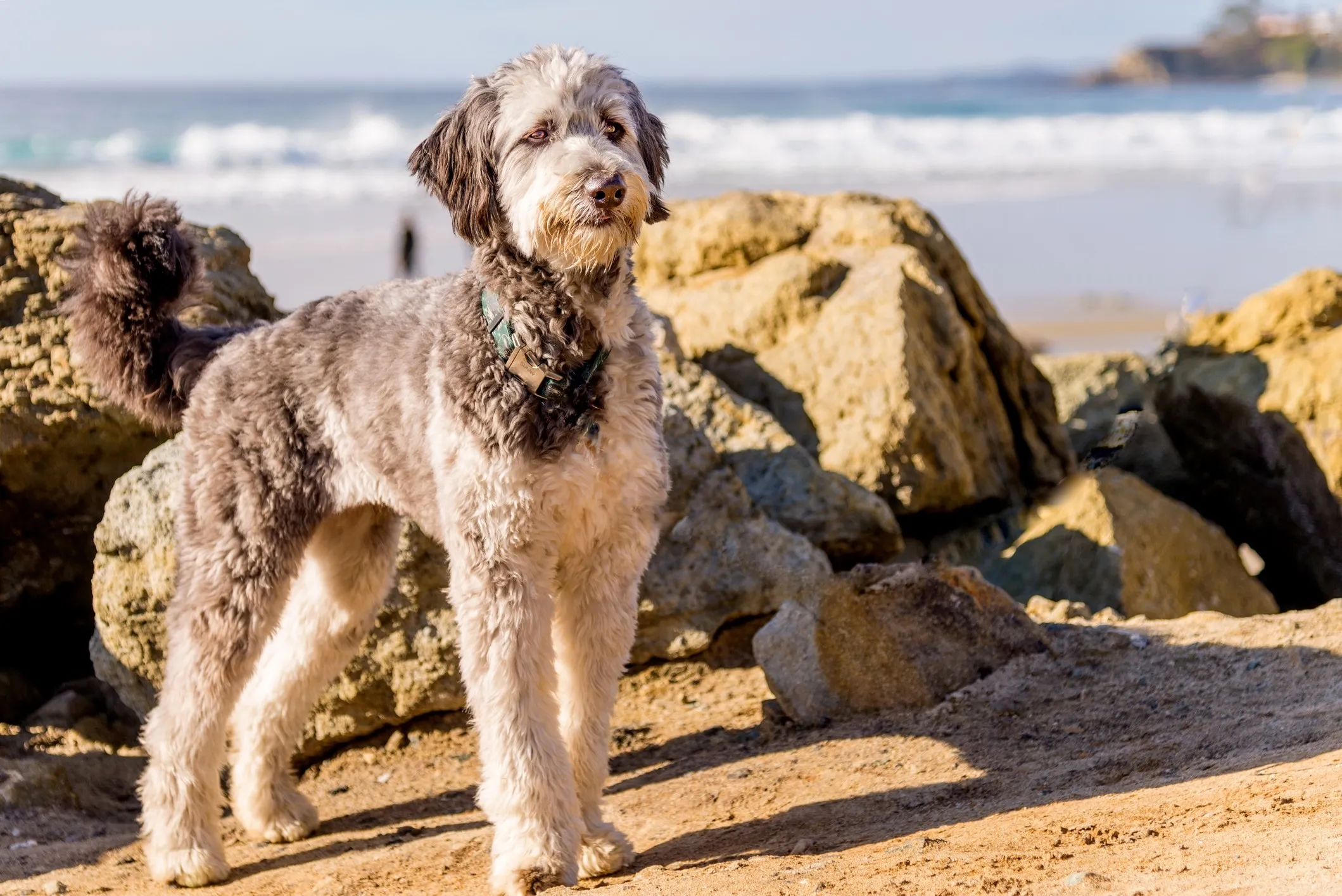 Standard Aussiedoodle dog standing on a beach
Standard Aussiedoodle dog standing on a beach
The Aussiedoodle is a dynamic crossbreed resulting from the pairing of an Australian Shepherd and a Standard or Miniature Poodle. While their size can vary based on the Poodle parent, many Aussiedoodles fall into the medium range, typically weighing between 25 and 70 pounds. They inherit a high level of intelligence and energy from both parent breeds, along with the low-shedding coat qualities of the Poodle. Their coats can be wavy or curly, and usually shed very little, though they require regular brushing to prevent tangles.
Aussiedoodles are known for being very smart, energetic, and affectionate dogs. They thrive on human companionship and are eager to please, making them highly trainable. However, their intelligence and high energy mean they need significant daily exercise and mental stimulation to prevent boredom, which can lead to destructive behaviors. Activities like agility, obedience, hiking, and interactive puzzle toys are ideal for this breed. Regular grooming, including brushing several times a week and professional trims every few months, is essential for maintaining their beautiful coats.
Soft Coated Wheaten Terrier
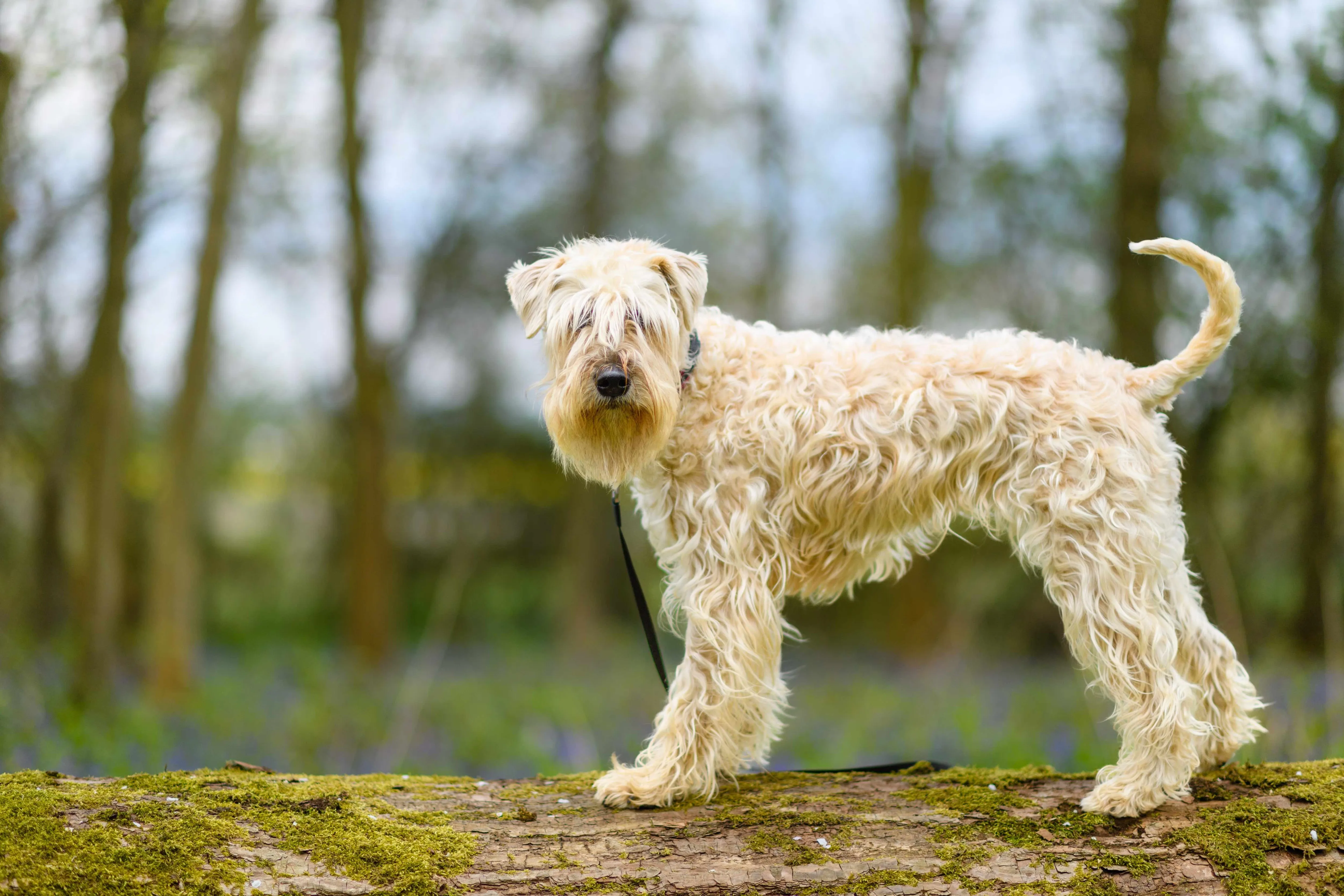 Soft Coated Wheaten Terrier dog on a log
Soft Coated Wheaten Terrier dog on a log
The Soft Coated Wheaten Terrier is a charming medium-sized Irish breed, weighing around 30-40 pounds. As their name suggests, they are famous for their incredibly soft, silky coat that has a distinctive wheaten color. This unique coat sheds minimally, making them a popular choice among allergy sufferers. However, despite being low-shedding, their single coat requires daily brushing to prevent mats and tangles, especially during puppyhood when their coat changes. Professional grooming every 4-6 weeks is also highly recommended.
Wheatens are known for their joyful, spirited, and affectionate personalities. They maintain a high energy level throughout their lives and are typically playful and devoted to their families. This breed requires ample exercise and mental stimulation to be on their best behavior, including daily walks, playtime, and opportunities to run. Early socialization and consistent training are crucial for Soft Coated Wheaten Terriers, as they can be boisterous and have a typical terrier stubborn streak.
Schnoodle
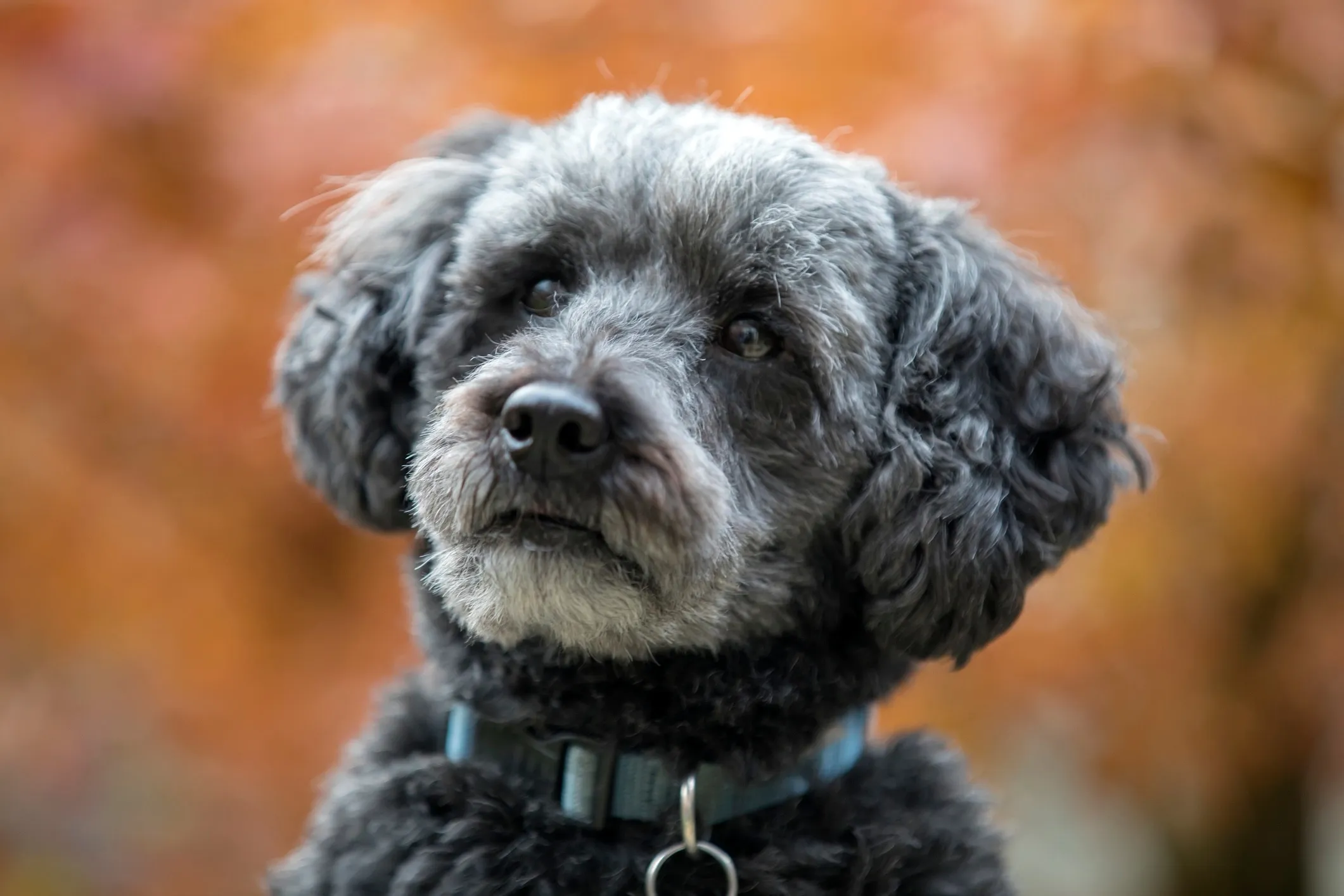 Gray Schnoodle close-up
Gray Schnoodle close-up
The Schnoodle is a designer breed that combines two low-shedding breeds: the Schnauzer and the Poodle. This makes them an excellent option for those seeking a dog that sheds very little. Schnoodles come in a range of sizes, but many fall into the medium category, typically weighing between 20-75 pounds, depending on the size of their parent breeds. Their coat can be curly or wavy, inheriting traits from either parent, but it is consistently low-shedding.
Schnoodles are known for their intelligent, playful, and affectionate nature. They are eager to please and highly trainable, making them suitable for various living situations, including apartments, as long as their exercise needs are met. This breed requires moderate daily exercise, such as walks, playtime in a yard, or engaging in dog sports. Regular grooming is essential for their low-shedding coats, including daily brushing to prevent mats and professional grooming every 6-8 weeks. Their cheerful disposition and adaptability make them wonderful companions.
Bedlington Terrier
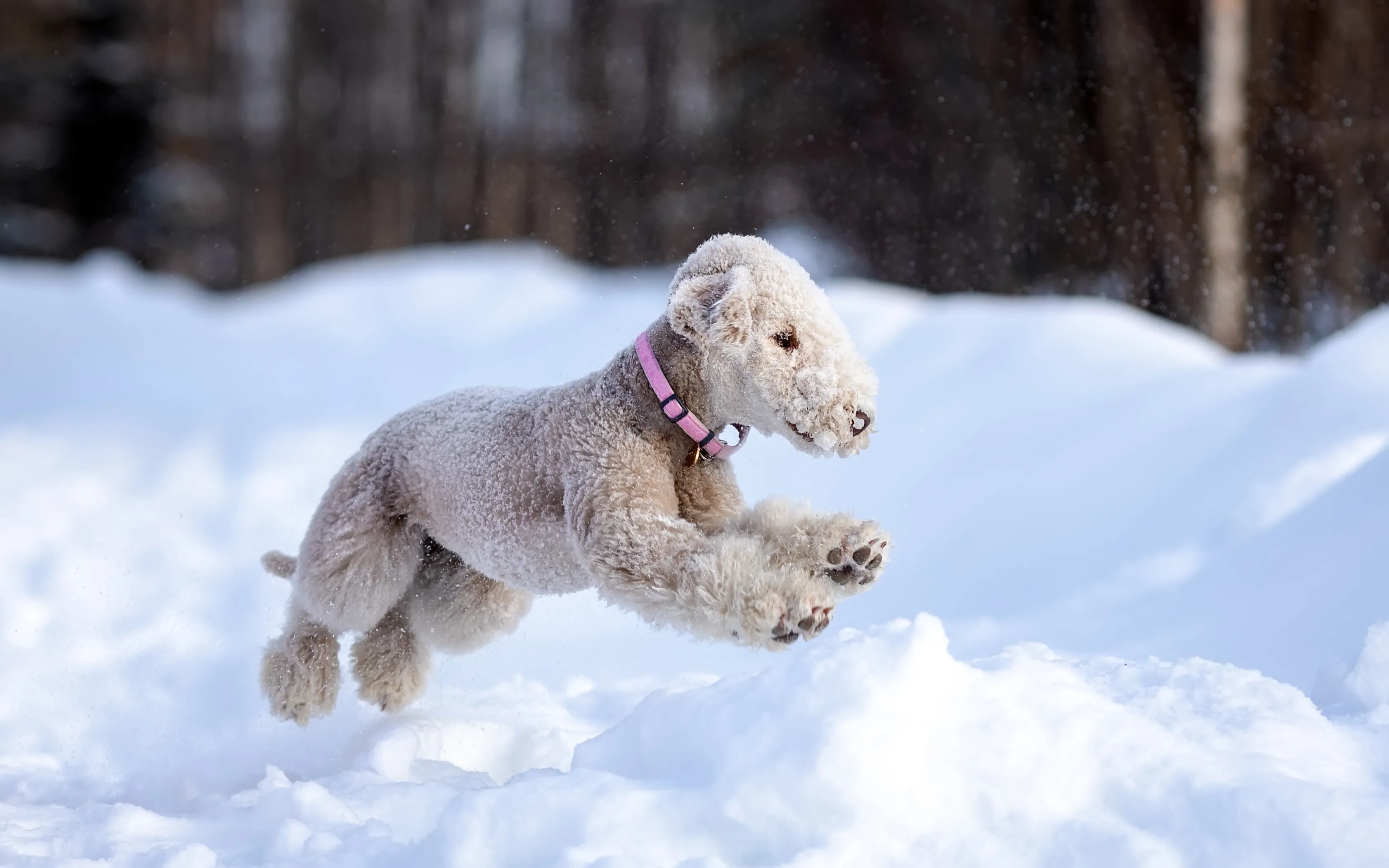 White Bedlington Terrier running through snow
White Bedlington Terrier running through snow
Often described as “a lamb in dog’s clothing,” the Bedlington Terrier is a distinctive medium-small breed, typically weighing 17-23 pounds. They are instantly recognizable by their pear-shaped head, arched back, and a unique, curly, woolly coat that feels like a lamb’s fleece. This coat sheds minimally, making them a good choice for people sensitive to dog dander. However, their coat requires consistent grooming, including weekly brushing and professional clipping every 4-6 weeks, to maintain its sculpted appearance and prevent mats.
Bedlington Terriers are charming, intelligent, and affectionate dogs with a playful and energetic temperament. They love being close to their people and can develop separation anxiety if left alone for extended periods. This breed requires moderate daily exercise, such as walks and playtime, to keep them happy and healthy. While gentle and loving with their families, they can have a typical terrier’s zest for life and may need firm, consistent training and early socialization to thrive.
Xoloitzcuintli (Standard)
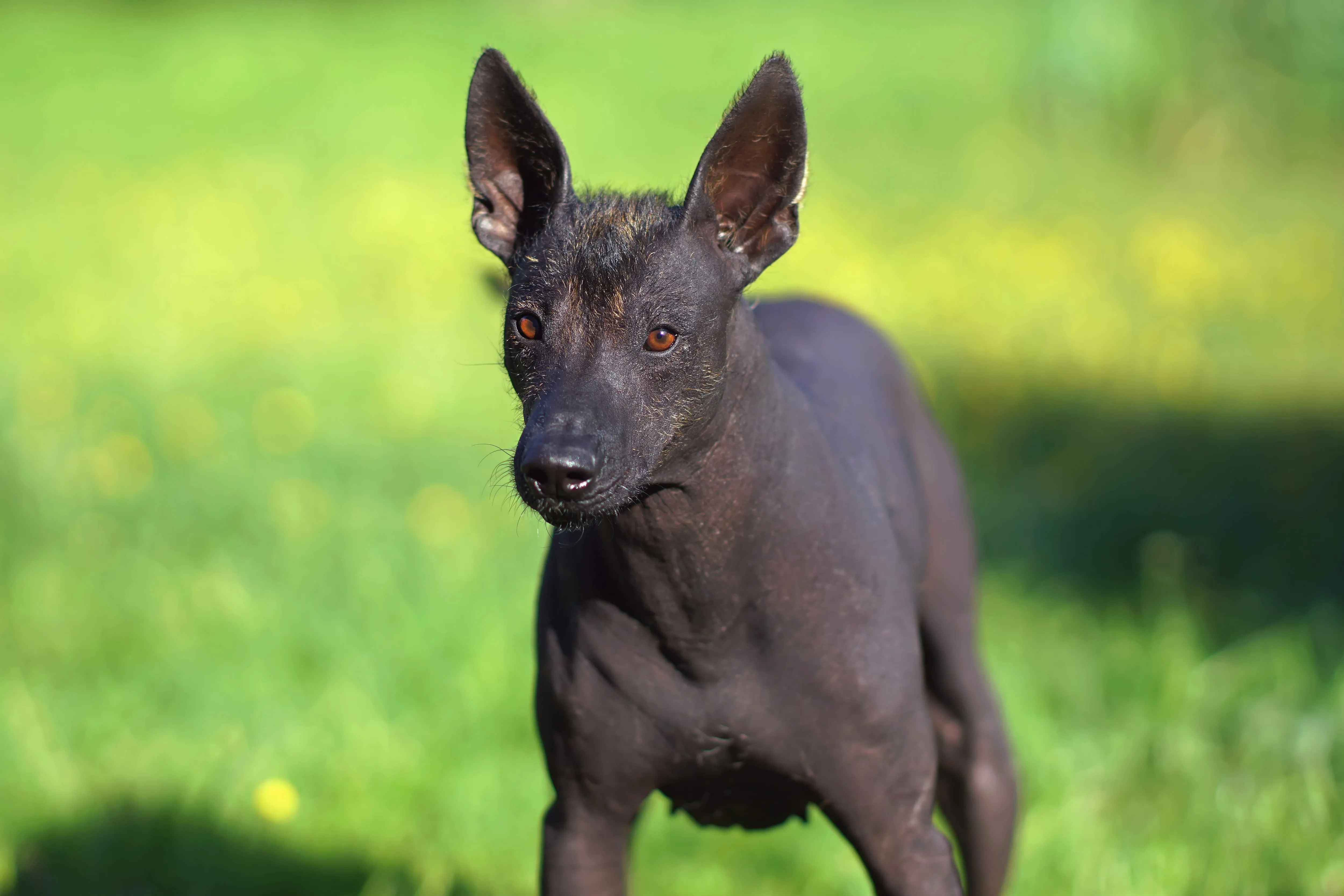 Black Mexican Hairless Dog standing in grass
Black Mexican Hairless Dog standing in grass
The Xoloitzcuintli (pronounced “sho-lo-eets-kween-tlee”), also known as the Mexican Hairless Dog, is an ancient and rare breed. They come in three sizes: toy, miniature, and standard. The standard size is considered medium, weighing 30-55 pounds and standing 18-23 inches tall. While known for their hairless variety, which is inherently low-shedding, there is also a coated variety with a short, smooth coat that also sheds minimally. Both types are excellent for allergy sufferers.
Xolos are known for their calm, vigilant, and loyal temperament. They form strong bonds with their families but can be reserved with strangers, making early socialization important. Despite their calm demeanor indoors, they are active dogs who require moderate daily exercise, such as walks, jogs, or playtime in a secure yard. The hairless variety needs special skin care, including sunscreen when outdoors and moisturizing to prevent dryness, while the coated variety is relatively low-maintenance. Their unique appearance and devoted nature make them fascinating companions.
Whoodle
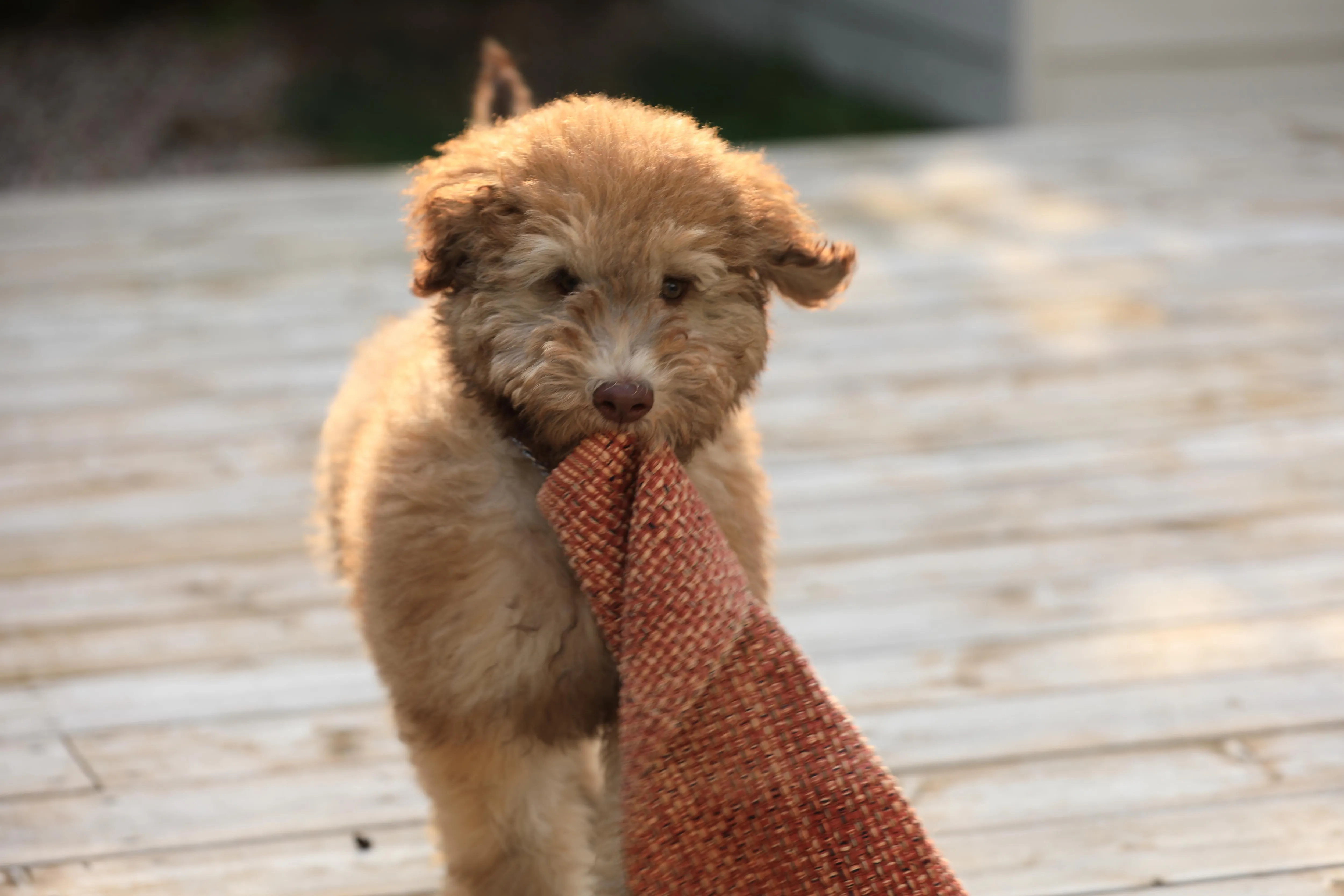 Tan Whoodle puppy dragging a wash cloth
Tan Whoodle puppy dragging a wash cloth
A Whoodle is a delightful cross between a Soft Coated Wheaten Terrier and a Poodle, bringing together two popular low-shedding breeds. As a result, Whoodles are known for their soft, wavy to curly coats that shed very little, making them an excellent choice for individuals seeking a dog with minimal hair around the house. Their size can range from small to medium, with most falling into the medium category, typically weighing between 20-50 pounds.
Whoodles inherit intelligence and an affectionate nature from both parent breeds, resulting in a friendly, playful, and loyal companion. They are generally good with children and other pets, and their eagerness to please makes them highly trainable. Whoodles are energetic dogs and require daily exercise, such as walks, games of fetch, or playtime, to keep them physically and mentally satisfied. Regular grooming, including daily brushing to prevent matting and professional trims every few months, is essential to maintain their beautiful, soft coats.
Peruvian Inca Orchid (Medium)
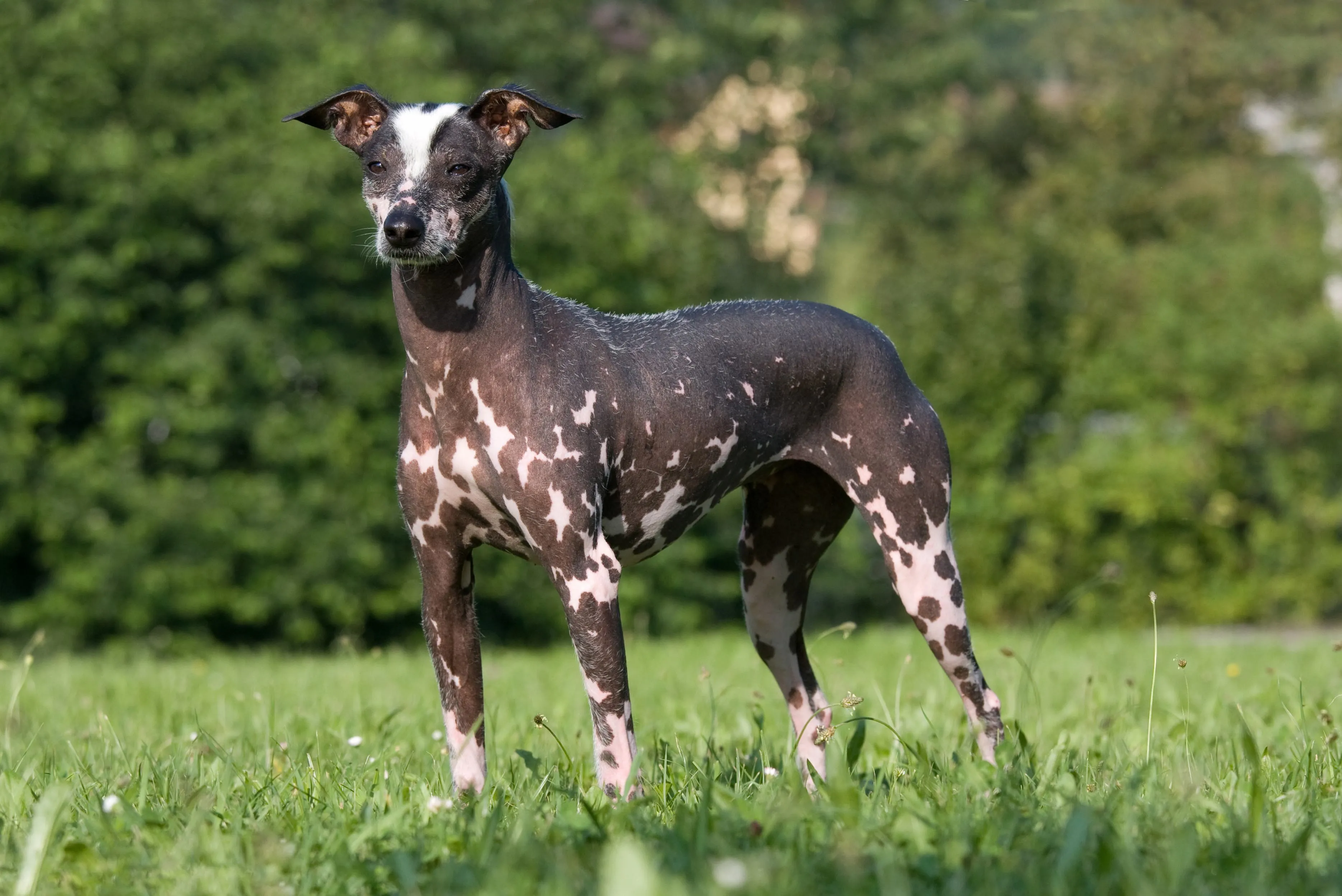 Peruvian Inca Orchid dog
Peruvian Inca Orchid dog
The Peruvian Inca Orchid is another ancient hairless dog breed, originally from Peru, and is considered the national dog of the country. Like the Xoloitzcuintli, they come in three sizes (small, medium, and large), with the medium size typically weighing 17-27 pounds and standing 15-20 inches tall. Their nearly hairless bodies naturally make them a fantastic choice for those sensitive to pet dander and shedding. Some varieties may have a small amount of hair on their head, paws, and tail, but shedding is virtually non-existent.
Peruvian Inca Orchids are known for their elegance, agility, and intelligence. They are attentive, affectionate, and protective of their families, though they can be wary of strangers. This breed requires moderate daily exercise to stay healthy and happy, such as walks and playtime. Special care is needed for their skin, including protection from sun exposure (sunscreen) and cold weather (clothing), as well as regular moisturizing to keep their skin healthy. Their unique history and devoted nature make them intriguing and loyal companions.
Essential Tips for Living with a Low-Shedding Dog
Even with a low-shedding dog, managing potential allergens and ensuring your dog’s well-being requires specific care. Adopting these practices can significantly enhance your quality of life and that of your furry friend.
Keep Up With Grooming
While these breeds shed minimally, their coats often grow continuously and can easily mat if not properly maintained. Regular grooming is paramount. This typically involves:
- Weekly Brushing: Many low-shedding breeds benefit from daily or weekly brushing to prevent tangles and remove any loose hairs or debris.
- Regular Bathing: Bathing your dog every 4-6 weeks can help remove dander and keep their coat clean. Using a specialized shampoo, such as an allergen-reducing formula, can further minimize pet dander.
- Professional Trimming/Hand-Stripping: Many of these breeds require professional grooming every 6-8 weeks for clipping or hand-stripping to maintain their coat health and desired appearance. Factor this into your budget or learn proper at-home grooming techniques.
Maintain a Clean House
Even with a low-shedding dog, allergens can still accumulate. A clean environment is key to minimizing allergic reactions.
- Vacuum Regularly: Use a vacuum cleaner with a HEPA filter on carpets, rugs, and upholstery to capture pet dander.
- Dust Frequently: Dust surfaces with a damp cloth to pick up airborne allergens.
- Wash Bedding: Regularly wash pet bedding and your own bedding in hot water.
- Air Purification: Consider using air purifiers with HEPA filters to reduce airborne allergens.
- Ventilation: Keep your home well-ventilated by opening windows when possible.
Consult Your Doctor and Veterinarian
Managing allergies and preventing allergic reactions is a collaborative effort between you, your healthcare provider, and your veterinarian.
- Healthcare Provider: Consult with your doctor to discuss allergy management strategies, which may include medication, nasal sprays, or allergy shots.
- Avoid Contact: While low-shedding dogs reduce dander, allergens are also present in saliva and urine. Try to avoid close contact with your dog’s face, and always wash your hands after handling them.
- Veterinary Care: Regular veterinary check-ups ensure your dog’s skin and coat are healthy, which can also help minimize dander production. Discuss any specific grooming or dietary needs with your vet.
Bringing a low-shedding medium-sized dog into your home can be a profoundly rewarding experience, allowing individuals with allergies to enjoy the unconditional love and companionship of a canine friend without constant discomfort. By understanding their specific needs and committing to a routine of proper grooming and home cleanliness, you can create a harmonious and healthy environment for everyone.
